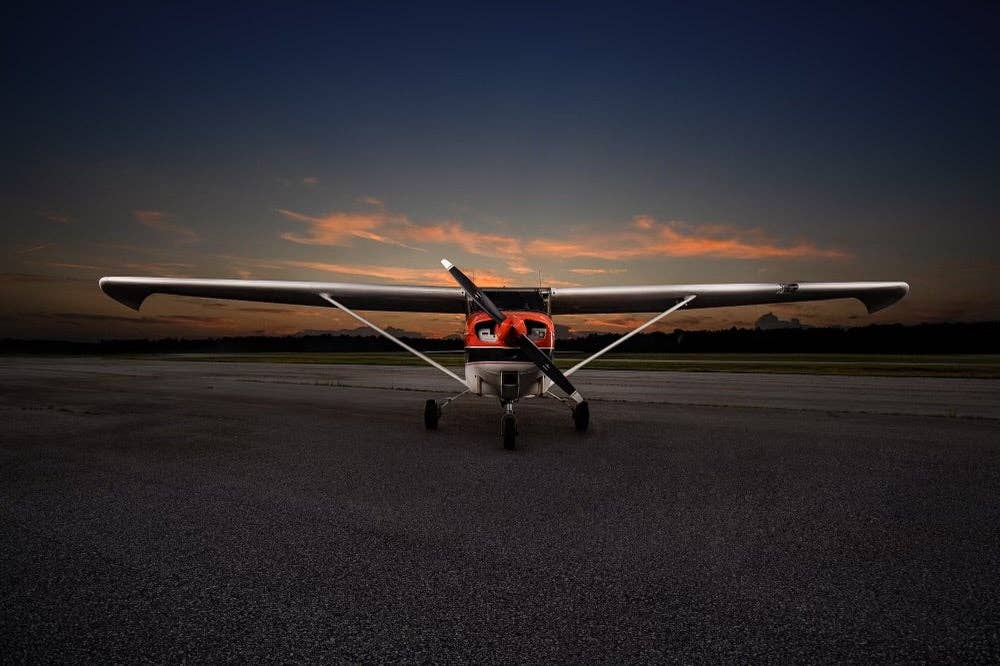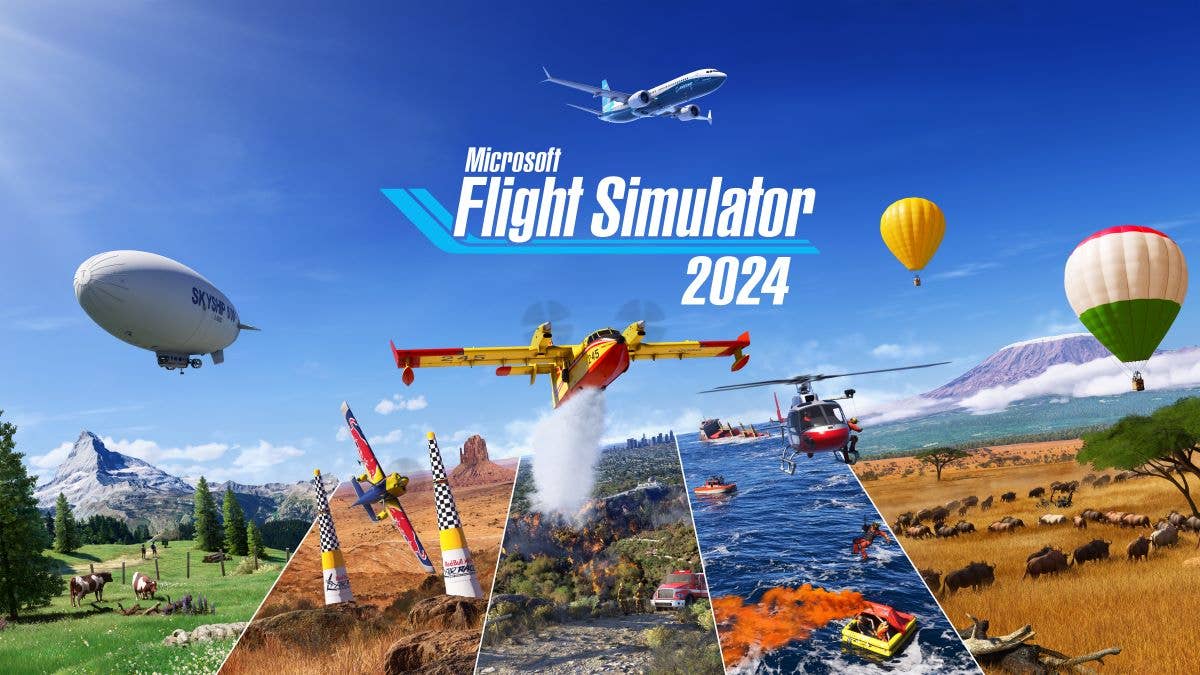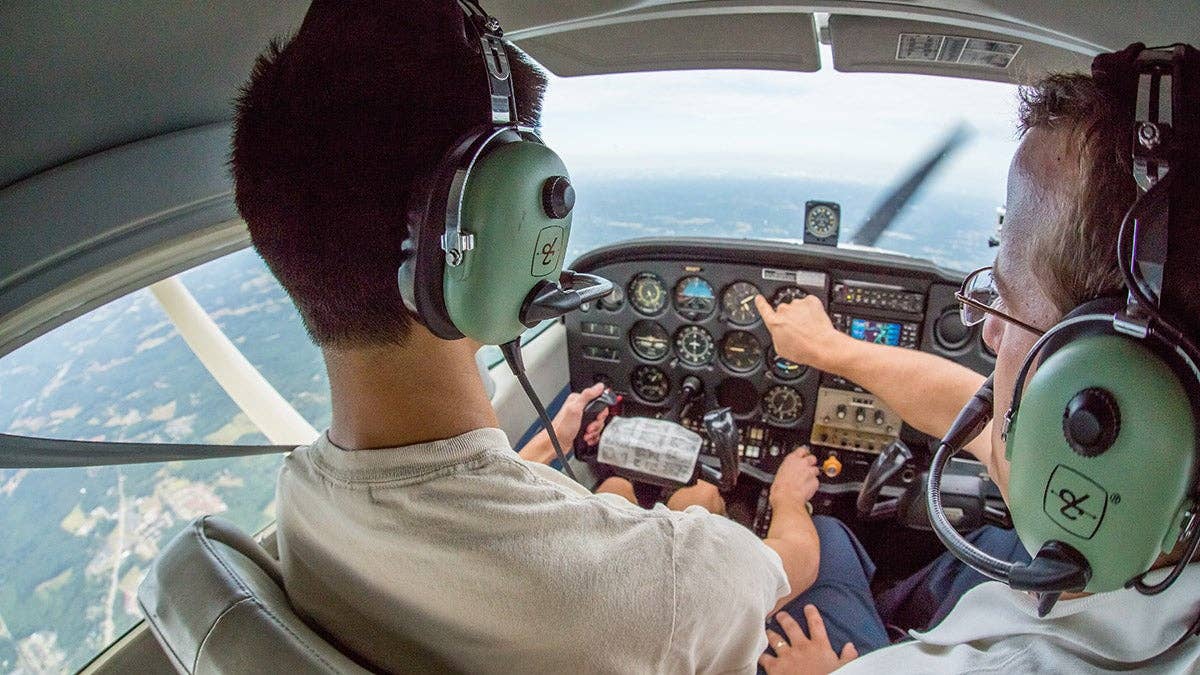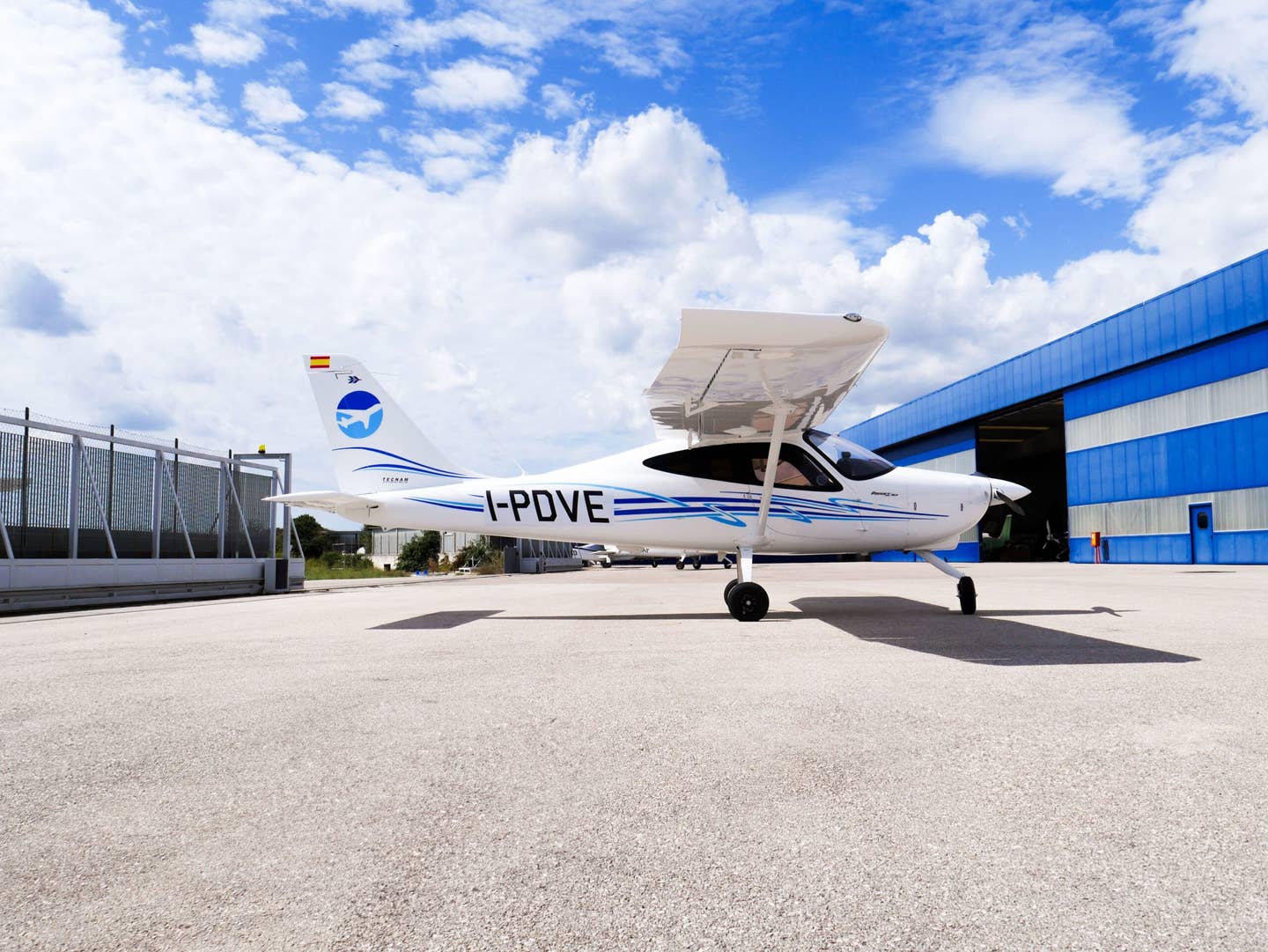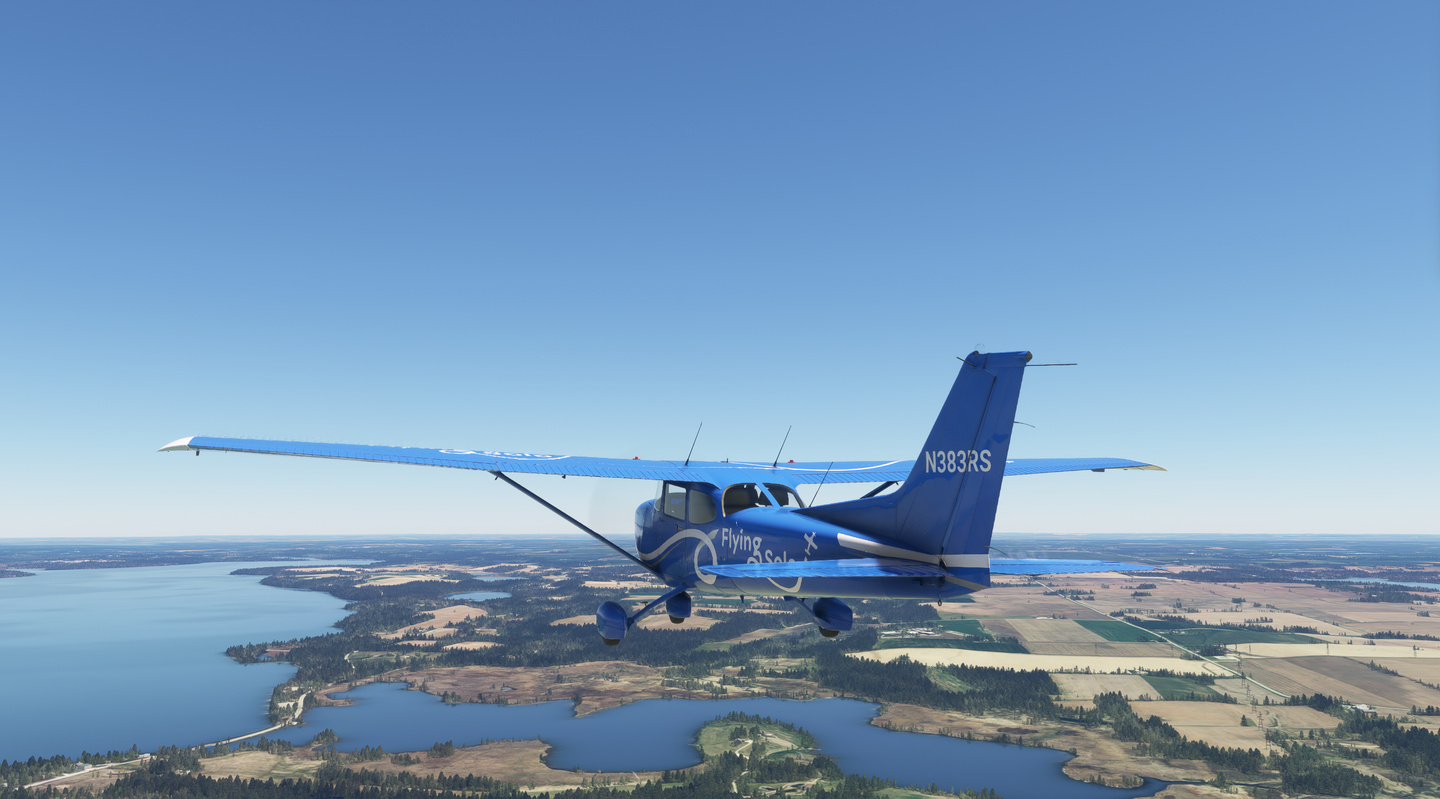Remembering the Most Successful Carrier-Based WWII Fighter
Ride along on a ‘Microsoft Flight Simulator 2020’ journey in a Grumman F6F Hellcat.
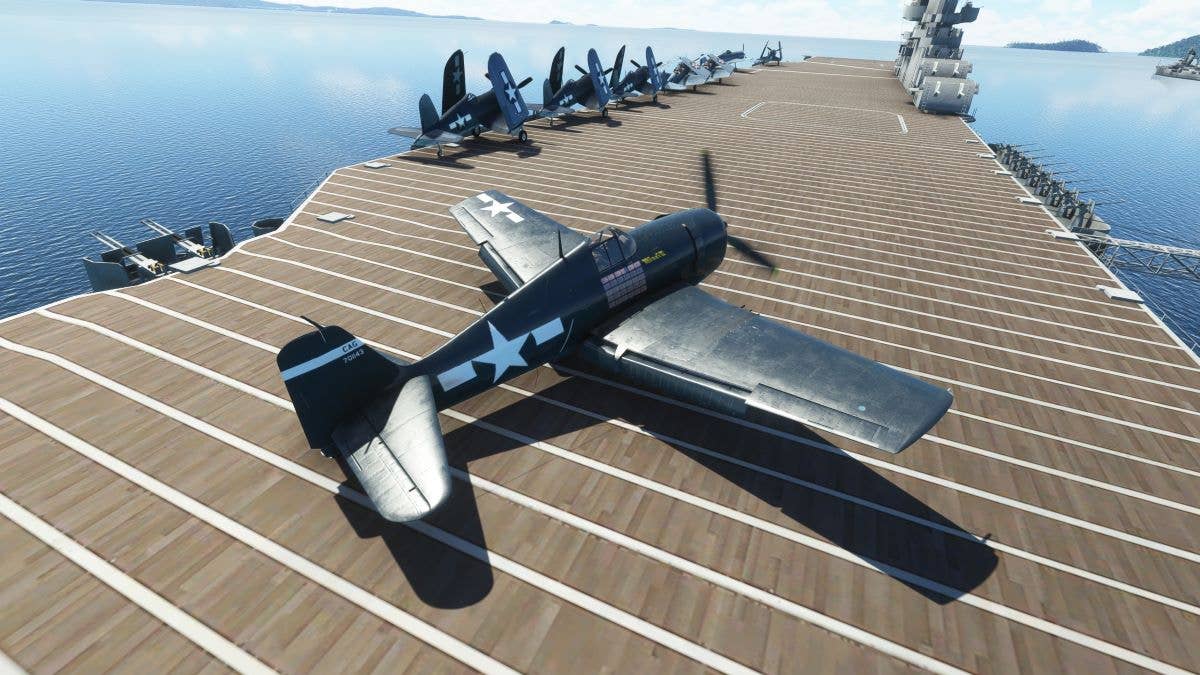
Grumman F6F Hellcat in Microsoft Flight Simulator 2020 [Courtesy: Patrick Chovanec]
Today in Microsoft Flight Simulator 2020, I’ll be flying the Grumman F6F Hellcat, the most successful carrier-based Allied fighter of World War II. And to tell that story, I’m aboard the USS Essex (CV-9) just off the eastern coast of the island of Luzon in the Philippines on the morning of October 24, 1944.
Just a few days before, on October 20, General Douglas MacArthur waded ashore on the island of Leyte to the south, fulfilling his pledge to “return” to the Philippines and liberate it from Japanese occupation. That summer, the U.S. Pacific carrier fleet had met the remaining Japanese carriers off the Marianas Islands.
In the “Great Marianas Turkey Shoot," U.S. pilots had wiped out their Japanese counterparts in the air. With its carriers denuded of aircraft, Japan now looked to its surface fleet based in Singapore, including its two mega-battleships the Yamato and Musashi, to sail to the Philippines and obliterate the American landing force on the beaches.
- READ MORE: Adapting to the Jet Age in a Fouga Magister
Off the east coast of the Philippines, Task Force 38, under the command of Admiral William Halsey, consisted of nearly a dozen full-size fleet carriers plus a score of smaller escort carriers, assigned to provide air cover for the landing. On the morning of October 24, planes aboard the Essex were fueling to take part in a strike on the advancing Japanese battleships, which had been detected by American submarines steaming toward the landing beaches through the archipelago south of Luzon.
In the starting days of WWII, the U.S. Navy’s main carrier-based fighter had been the Grumman F4F Wildcat. The creator of the Wildcat—and later the Hellcat—was Leroy Grumman, who headed a relatively modest aircraft company of the same name based on Long Island, New York.
Grumman began his aviation career as a naval pilot during World War I. Though he failed his medical exam due to flat feet, a clerical error allowed him to get through flight training.
Grumman was assigned by the Navy as a test pilot to help assess aircraft produced by Grover Leoning, a German immigrant who graduated from Columbia University with the world’s first degree in aeronautical engineering and then learned his craft working for Orville Wright. Grumman became Leoning’s protege and worked for him as a designer and floatplane test pilot after the war for the Navy.
When Leoning’s company was acquired in 1929, Grumman formed his own, retaining his focus on naval aviation. By the time the U.S. Navy adopted the Grumman F3F biplane as its main carrier-based fighter in the years immediately prior to WWII, Grumman was well established as a go-to supplier of combat aircraft to the Navy.
The F4F Wildcat (the F3F’s successor) came into service a year before Pearl Harbor. It was not as maneuverable as the Mitsubishi A6M “Zero,” and the cockpit had poorer visibility. But it could outdive the Zero and could also take a lot more punishment than its fragile Japanese rival. Overall, the Wildcat and the Zero were fairly evenly matched, each with its own strengths and weaknesses.
As the early war in the Pacific unfolded, Grumman sent its designers to the field to talk with pilots flying the F4F Wildcat against the Zero in combat. They asked veteran F4F aces like Edward “Butch” O’Hare (for whom Chicago’s O’Hare Airport is named) what kind of improvements they needed to defeat the Zero.
The result was the F6F Hellcat. Superficially, the Hellcat looks a lot like the F4F Wildcat, and at first glance can be hard to tell apart. But there are a few telltale differences. First of all, when lined up next to each other, it’s clear that the Hellcat is longer, larger, and taller than its predecessor, earning it the nickname “the Wildcat’s big brother.”
The most obvious difference, once you know where to look, is the landing gear. The F4F’s gear could be retracted into the fuselage but had to be cranked by hand—not the easiest task just before or after landing on an aircraft carrier. The Hellcat’s gear, in contrast, could be raised and lowered automatically, using hydraulics. Because they retracted into wing wells, the wheels were wider apart, making them more stable to land on without tipping over.
One of the most distinctive features of both Grumman fighters was their foldable wings, which saved deck and hangar space, making it possible for a ship to carry a third more airplanes. (In contrast, Japanese Zeros did not have folding wings). When lowered for flight, the wings were locked into place with a big hydraulic metal bolt—the white circle you can see next to the red hook.
The Hellcat’s flaps have only one setting, up or down. The outer flap section is canvas-covered, the inner one is metal, so the pilot can step on it to climb into the cockpit. A major innovation on the Hellcat is spring-loaded flaps. If lowered at too high a speed, the air current would push them back up again. That meant pilots didn’t have to be distracted worrying about exceeding the maximum flap speed (170 knots), either when dogfighting or coming in to land.
Of course, the Hellcat has a tailhook for catching a wire on the carrier deck, allowing it to come to a quick stop. The rear wheel is made of solid rubber to put up with the pounding and abuse typical aboard cramped aircraft carrier decks.
- READ MORE: Recreating the de Havilland Tiger Moth
Both the Wildcat and Hellcat were built like a stubby beer barrel—there was no competing with the sleek elegance of a British Supermarine Spitfire or American P-51 Mustang. The F6F replaced the F4F’s single Pratt & Whitney Twin Wasp 1,200 hp engine with a Double Wasp capable of producing 2,000 hp. For perspective, that’s more than 10 times the horsepower of a Cessna 172.
Though they used the same powerful engine, the Hellcat’s nose was much shorter than the U.S. rival F4U Corsair and angled slightly downward, making it much easier to see during carrier landings. This is a major reason why the F6F became the Navy’s main carrier-based fighter, while the otherwise fast and powerful F4U was relegated to the Marines, who were mostly based on land.
The main armament of the F6F Hellcat was three 50-caliber Browning machine guns on each wing (vs. two per wing on the older Wildcat). I’ll talk more about combat tactics in the Hellcat when we’re in the air.
And we’ll be in the air soon, because this morning we’re joining David McCampbell, commander of Fighter Squadron 15 (VF-15) aboard the USS Essex, as he refuels for a strike mission on the Japanese battleships. To the right of the cockpit are our lights and radio switches, as well as our engine gauges. To the left, as usual in a WWII fighter cockpit, the throttle, mixture, and prop controls, trim wheels, flaps, landing gear, etc.
While McCampbell is fueling, word comes in over the flight deck loudspeaker: A wave of land-based Japanese planes is inbound from the Philippines to attack the American carrier fleet. The planned mission is scrubbed—all fighters must get into the air to meet them. McCampbell disengages the fueling, with his tanks only half full, and immediately readies for takeoff despite the crowded deck.
At this point in the war, some carriers did have catapults, but many takeoffs took place without them. Flaps down. Brakes on. Rev to no more than 2,000 rpm—any faster and the Hellcat will tip over. Release brakes and put in full throttle.
There’s a slight lurch as we leave the flight deck, then steady climb. Gear up. Flaps up. And we’re off to meet the incoming Japanese planes. The flight control officer that just launched us from the Essex was Lieutenant John Connally Jr., the future Secretary of the Navy and governor of Texas who, not quite 20 years later, would be wounded sitting in the car in front of John F. Kennedy when the president was assassinated in Dallas in 1963.
As we level off and search for the Japanese planes, I bring the throttle back to 44 inches manifold pressure and reduce the prop to 5,500 rpm. These are the Hellcat’s cruise settings, and if I go higher in altitude (up to a service ceiling of 37,300 feet), I can engage the supercharger to keep the manifold pressure up.
While the Wildcat was roughly matched to the Zero, its strengths compensating for its weaknesses, the Hellcat completely outclasses its opponent, which was designed to its limits and has not been improved since the war began. McCampbell has already shot down 21 enemy planes, many of them during the "Great Marianas Turkey Shoot" that summer.
- READ MORE: Recreating the Final Flight of the Red Baron
This morning, he and his wingman Roy Rushing get separated from the rest of his squadron. They’re on their own, looking for enemy planes. Suddenly, in front of them they see a host of nearly 60 Japanese planes, a motley mix of fighters and bombers thrown at the U.S. fleet from land bases in Luzon.
Without a second thought, outnumbered 30-to-one, the two Hellcats engage. I put my throttle full to nearly 48 inches manifold pressure and put the prop to max 7,000 rpm for full combat power.
The Hellcat still can’t outturn the Zero in close combat, but it doesn’t need to. It uses its superior power to hit fast and hard from on high. Its superior armor allows it to shrug off stray enemy bullets as it plows through enemy ranks. Speed was another crucial factor. The F6F had a maximum speed of 391 mph, compared to 331 mph for both the F4F and Zero.
From the day it was introduced in 1943 to war’s end, the Hellcat racked up a kill ratio of 19-to-1 (19 Japanese planes shot down for every Hellcat lost). Against the Zero it was 13-to-1. This ratio was partly the result of the Hellcat’s innate superiority but also the result of severe losses among trained Japanese pilots and the inexperience of the pilots who replaced them.
On this morning—October 24, 1944—McCampbell shot down nine enemy planes, seven Zeros and two Nakajima Ki-43 Hayabusas, or “Oscars,” setting a U.S. single-mission aerial combat record. His wingman shot down another six for a total of 15.
McCampbell soon realized, though, that having taken off on only half-filled tanks, he was quickly running out of fuel and needed to land as soon as possible. The flight deck of the Essex was full, so he was waved off and had to land on the escort carrier USS Langley (CVL-27) instead. (I only have the USS Essex, so I’ll have to make due.)
When McCampbell landed on the Langley, he discovered that he had just two bullets left in his magazines, and the engine gave out immediately for lack of fuel, even before they could push him off the landing wires. McCampbell received the Medal of Honor for his actions that day. He downed a total of 34 enemy planes by the end of the war, making him the U.S. Navy’s all-time leading ace. He survived the war and lived until 1996.
But the battle that day was far from over.
In the air above the same carrier task force, the Hellcats of VF-27, each painted with a distinctive “cat’s mouth” nose, were on the hunt. VF-27 was based on the light carrier USS Princeton (CVL-23). Hellcat No. 7 (aka Paper Doll) was normally flown by Ensign Robert Burnell, who came up with the idea to paint the unconventional color scheme on each of the squadron’s planes. On this day, however, Paper Doll was being flown by Lieutenant Carl Brown Jr. of Texarkana, Texas. Hellcat No. 17 was flown by Lieutenant Richard Stambook, of Kansas City, Missouri, already a double ace who had earned the Silver Star during the Marianas Turkey Shoot.
That morning, the squadron engaged another large group of 80 Japanese planes heading from Luzon to attack the American carriers. Between them, the cat’s mouth Hellcats shot down 36 of them. Brown shot down five of those, making him another “ace in a day” and earning him the Navy Cross.
Meanwhile, some of the Japanese planes made it through. Shortly before 10 a.m., a single bomb hit the flight deck of the Princeton, setting it on fire. The cruiser USS Birmingham (CL-62) came alongside to fight the fire and render assistance. Then at 3:24 p.m., a huge explosion—probably the detonation of stored bombs and torpedoes—ripped through the Princeton, doing severe damage to the Birmingham alongside, killing 233 and injuring 426 on the latter.
Stambook and most of VF-27 were on the Princeton refueling when the attack came. When the secondary explosion occurred, he and others jumped overboard and were rescued. Their planes were obviously lost. At 5:49 p.m., a third even larger explosion blew apart the front section of the Princeton and it sank moments later. Surprisingly, due to daring rescue efforts, only 108 aboard were lost, while 1,361 were saved.
Elsewhere, Brown and a handful of other VF-27 pilots were able to land on the Essex, where apparently their non-regulation cat’s mouths drew some raised eyebrows. That reaction didn’t last long as the squadron’s Hellcats had to be pushed off the Essex’s overcrowded flight deck to make room for ongoing operations.
When VF-27 later received a new home and new Hellcats aboard the USS Independence (CVL-22), it was without their signature cat’s mouths. Overall, though, the squadron claimed 136 enemy aircraft shot down before the Princeton was sunk, plus one more before the war’s end.
Not all the Navy’s Hellcats played defense that day.
Recall that McCampbell was fueling up for a strike on Japan’s super-battleships when the word came that the enemy's planes were inbound. A third carrier in the same task group, the Lexington (CV-16), launched a strike force that included F6Fs armed with 4,000 pounds of bombs. We join them now, flying across the southern isthmus of Luzon to attack their Japanese targets.
This particular Hellcat, No. 99, known as Hangar Lilly, was flown by the commander of Lexington’s VF-19 fighter squadron, Theodore “Hugh” Winters of Society Hill, South Carolina. Winters had already flown in the Allied invasion of North Africa before switching to the Pacific in 1943. He shot down several Japanese planes over the Philippines the month before in preparation for the U.S. landings on Leyte.
Time to jettison our drop tank and begin our attack run on the Japanese fleet trying to sneak its way through the Sibuyan Sea. Winters led his squadron of Hellcats, along with dive bombers and torpedo bombers from the Lexington, through a rain of enemy anti-aircraft fire to hit the Japanese fleet, including the battleship Musashi.
Two Japanese battleships and four cruisers were severely damaged in the attack, including the Musashi, which was sunk. Winters continued flying through withering anti-aircraft fire to gather critical intelligence on the damage done to the Japanese fleet, for which he was awarded the Navy Cross.
U.S. commanders wrongly assumed that the sinking of the Musashi had stopped the Japanese fleet. So Admiral Halsey sent his carriers (including the Lexington) in pursuit of a group of Japanese carriers to the northeast. That next day, October 25, Winters again helped lead the attack, contributing to the sinking of one fleet carrier and two light carriers—for which he received his second Navy Cross in two days.
But the Japanese carriers were meant as a diversion. They hardly had any planes and posed no real threat. Halsey had been fooled into leaving a critical strait unguarded. The rest of the Battle of Leyte Gulf unfolded farther to the south. The U.S. Navy emerged victorious, and the landing beaches were protected, but Halsey still experienced fierce criticism.
The U.S. was not the only Allied navy to rely on the F6F Hellcat. Britain’s Royal Navy received 1,263 F6Fs under lend-lease. Initially redubbing it the “Gannet,” the British quickly reverted to the popular Hellcat name for simplicity.
The Pacific was a carrier-based naval war. In the Atlantic, in contrast, the Hellcat had fewer opportunities to go head-to-head with the German Luftwaffe. We’re joining the HMS Emperor in the North Sea for one such episode. Operation Hoops, in May 1944, was a carrier-based operation launched from Scapa Flow to harass German coastal shipping off the coast of occupied Norway. This particular aircraft was flown by Lt. Blythe “Jock” Ritchie of No. 800 Squadron.
Just the previous month, the squadron had escorted a bombing raid that had seriously damaged the German battleship Tirpitz (sister ship of the Bismarck) as it hid in a Norwegian fjord. Now they were back, hitting oil tanks at Kjen and a fish oil factory at Fosnavaag.
Suddenly the Hellcats came under attack from a group of German fighters. Ritchie succeeded in shooting down a Focke-Wulf Fw 190—his fifth kill and his first in a Hellcat. His mates shot down two Messerschmitt Bf 109s, at a loss of one Hellcat. But the defeat of the formidable Fw 190 in a head-to-head dogfight showed that the F6F could compete with the best the Germans could throw at it.
Many British pilots preferred the F6F Hellcat to the sleeker Supermarine Seafire (a version of the Spitfire adapted for carrier operations), in large part because it was easier to land safely. The wider undercarriage and slower approach speed of the Hellcat made it much simpler to land on a carrier deck without tipping over.
A few months later, in August 1944, the HMS Emperor and No. 800 Squadron’s Hellcats had relocated to the Mediterranean coast of France to support the Allied invasion there, Operation Dragoon. This particular F6F, painted with “invasion stripes” for the operation, was flown by a Dutch pilot, Charlie Poublon. It was forced to ditch off the Spanish coast after being hit by flak.
British F6F Hellcats also flew in the Indo-Pacific Theater, like this one from No.1839 Squadron from the HMS Indomitable, patrolling over the coastal jungles of Sumatra in early 1945. Overall, British Hellcats claimed a total of 52 enemy aircraft kills during 18 aerial combat missions from May 1944 to July 1945. After the war, they were rapidly phased out in favor of British aircraft.
Meanwhile, Grumman kept churning out F6F Hellcats for the U.S. Navy by the thousands in its factory in Bethpage, New York. In May 1945, the 10,000th Hellcat was delivered to Bombing Fighting Squadron VBF-87 on the USS Ticonderoga (CV-14). It was flown by the squadron’s commander, Porter “Maxie” Maxwell of Charleston, West Virginia, a 1936 graduate of the U.S. Naval Academy.
VBF-87 was created to conduct air support and bombing operations aimed at Japan’s home islands in preparation for an expected invasion landing—including attacks on the massive naval yards at Kure, where the super-battleships Yamato and Musashi had been built.
But this was no victory lap. On July 24, Maxwell and his squadron were flying near Kure, seeking out air bases where Japanese kamikaze aircraft might be hiding, when suddenly Maxwell’s wingman saw his tail disintegrate, most likely from ground fire. Maxwell tried to bail out at the last moment, but his parachute didn’t open and he hit the water next to his plane and perished at age 31.
Less than a month later, the war was over.
A total of 12,275 F6F Hellcats were produced in just two years during the war. They flew 66,530 combat sorties for the U.S. Navy and Marines and claimed 5,163 kills—over half of all U.S. Navy/Marines air victories in the Pacific—with only 270 Hellcats lost in air-to-air combat and 553 to ground fire. The F6F produced the most aces (305) of any aircraft in the U.S. inventory.
The top ace, McCampbell, called the Hellcat “an outstanding fighter plane. It performed well, was easy to fly, and was a stable gun platform, but what I really remember most was that it was rugged and easy to maintain.”
After the war, the Hellcat’s job was not quite over. In summer 1946, the U.S. tested two atomic bombs on an armada of surplus vessels at the Pacific atoll of Bikini in the Marshall Islands. To help evaluate the tests, the U.S. military assembled a small fleet of pilotless drones, consisting of F6F Hellcats and B-17 bombers. The Hellcat drones took off from an airfield on Roi Island off Kwajalein. Within hours of the detonations, the F6F drones were flown by remote control over the test site, collecting information on radiation, air pressure, and physical damage.
The Navy continued to fly Hellcats drones for research well into the 1950s. It also experimented with using unpiloted Hellcat drones as “suicide” bombs against hardened targets during the Korean War. That effort was largely unsuccessful.
The drone program gave rise to at least one crazy incident in 1956 where a Hellcat drone went rogue and circled over the heavily populated Los Angeles area for several hours, while jet fighters scrambled to try to shoot it down safely. The jets fired 208 missiles at the Hellcat, and all missed. Eventually it ran out of fuel and crashed, lighting a brushfire. You can read about the so-called “Battle of Palmdale” here.
A bit more inspiring postwar role for the F6F Hellcat came about in early 1946, when it was chosen as the aircraft for a new U.S. Navy Flight Demonstration Squadron. Its first aerobatics display took place at Jacksonville, Florida, to celebrate the opening of the city’s new municipal airport. Decked out in navy blue with gold letters, the team of Hellcats soon became known as the “Blue Angels." Needless to say, the Navy Blue Angels continue to perform (now flying FA-18 jet fighters) to this day.
Most wartime F6Fs, however, were sold for scrap. A handful continued to serve in combat, such as the French Hellcat based at Tan Son Nhat outside of Saigon (in French Indochina) in 1952, fighting the Viet Minh. The last country to fly the Hellcat was the Uruguayan Navy, which used them until the 1960s. Today, worldwide, out of over 12,000 produced, there are only five F6Fs still capable of flying.
I hoped you enjoyed this brief glimpse into the story of the Grumman F6F Hellcat, the most successful carrier-based fighter plane in WWII. If you’d like to see a version of this story with more historical photos and screenshots, you can check out my original post here.
This story was told utilizing FlyingIron Simulations’ F6F-5 Hellcat add-on to Microsoft Flight Simulator 2020, along with liveries, scenery, and ships downloaded for free from the flightsim.to community.

Subscribe to Our Newsletter
Get the latest FLYING stories delivered directly to your inbox

